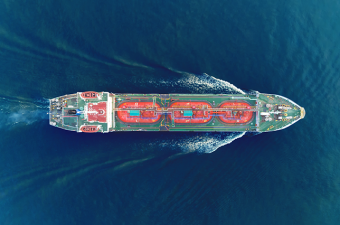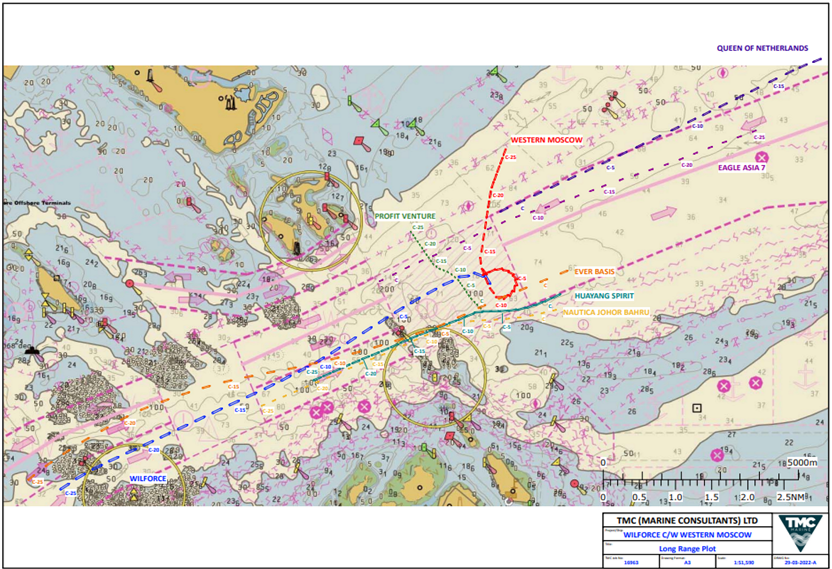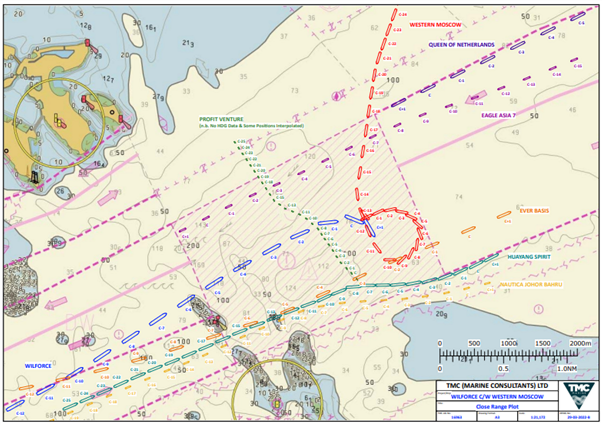
OVERVIEW
Since last year’s historic Supreme Court decision in Evergreen Marine (UK) Ltd. v. Nautical Challenge Ltd. [2021] UKSC 6, the Admiralty Court has now considered the scope and application of rules 15 – 17 of the International Collision Regulations (“the crossing rules”) on two occasions: in the re-apportionment trial in Nautical Challenge Ltd. v. Evergreen Marine (UK) Ltd. (No.2) [2022] EWHC 206 and now in The “Wilforce” [2022] EWHC 1190.
On 31 May 2019 a collision occurred in a busy Precautionary Area of the Singapore Strait Traffic Separation Scheme between the LNG WILFORCE and the bulk carrier WESTERN MOSCOW. Navigation in the Precautionary Area was also governed by (Singaporean) local rules. The Judge noted that this was the first occasion when the Admiralty Court had considered responsibility for a collision in a Precautionary Area.
The notion of a Precautionary Area was created by the IMO and subsequently introduced into the TSS in the Singapore Straits. By Port Marine Circular No.4 (2013) the Maritime and Port Authority of Singapore promulgated the measures which should be taken by vessels crossing the TSS and Precautionary Area (which replicated the IMO Recommendations in SN.1/Circ. 317 (4/12/2012)).
As is now the case with most collisions, both vessels had Voyage Data Recorders and a reconstruction was agreed in advance of the trial. For ease of reference the (agreed) Long and Short Range Plots are attached to this Article.
WESTERN MOSCOW had been intending to proceed westbound in the TSS but considered that she was constrained by the presence of the southbound tug and tow (“Profit Venture”). Accordingly she entered the Precautionary Area and proceeded southbound before executing a port turn to proceed back towards the westbound lane of the TSS. WILFORCE was proceeding eastbound at a speed of about 15 knots.
Before addressing the Judge’s approach to the application of the crossing rules, there are two aspects of the Judgment which should be noted.
First, the Judge considered that the navigation of the vessels before about C-10 were not causatively relevant since, prior to C-10, there was no risk of collision, even though some aspects of the navigation of WESTERN MOSCOW were at best questionable. If WESTERN MOSCOW had continued her north or north-westerly course at C-7 the vessels would have passed safely. The navigation of the vessels prior to about C-10 were thus part of the historical context for the collision rather than an effective cause.
Second, there were some limited VHF exchanges between the two vessels after C-3 during which a VHF agreement to pass port-to-port was concluded. Since VTIS had requested WESTERN MOSCOW to call WILFORCE to tell her what WESTERN MOSCOW proposed to do, WESTERN MOSCOW was not to be criticised: see [92]. Thus the “traditional” approach to the use of VHF as set out in “The Mineral Damper” [2001] 2 Ll.R. 419 was not applied. The real criticism was that WESTERN MOSCOW had not complied with her own agreement but continued to turn to port until about C-1½ instead of applying starboard helm [93].
The crossing rules
The Judge then examined the scope and application of the crossing rules at [106] et seq.
WESTERN MOSCOW alleged that WILFORCE was the give-way vessel and failed to act in accordance with rule 16 from about C-7. It was further alleged on behalf of WESTERN MOSCOW that she had complied with Rule 17(a)(i) and maintained her course and speed by continuing her turn to port [156]. WESTERN MOSCOW sought to maintain that WILFORCE should bear the preponderance of the blame.
WILFORCE submitted that the crossing rule did not apply because it was only WESTERN MOSCOW’s fault in continually porting after C-7 rather than proceeding across the Precautionary Area in a north-westerly direction that brought about the crossing situation. WILFORCE relied upon the orthodox proposition that a vessel could not invoke the crossing rule when she herself created the crossing situation as established by The “Spyros” [1953] 1 Ll.R. 501 at 509 (per Lord Merriman); The “Toju Maru” [1968] 1 Ll.R. 501 at 509 (per Willmer LJ); The “Forest Pioneer” [2007] EWHC 84 at [39] (per Steel J), and the Judge’s own decision in the (first) Nautical Challenge Ltd. v. Evergreen Marine (UK) Ltd. [2017] EWHC 453 at [66].
WESTERN MOSCOW challenged this proposition on the basis that it was inconsistent with the reasoning of the Supreme Court that the crossing rule applied where the bearing of one vessel from the other remained constant as it did in the present case from C-7, notwithstanding that this was the consequence of WESTERN MOSCOW’s continuation of her port turn. WESTERN MOSCOW also alleged that the orthodox proposition was inconsistent with the Court of Appeal’s decision in The “Century Dawn” [1996] 1 Ll.R. 125 at 132 although this was rejected by the Judge at [128] – [131].
What about the orthodoxy that a vessel could not invoke the crossing rule when she herself created the crossing situation as established? The Judge analysed the authorities at [110] – [127] and [133] and noted that the approaches were not necessarily consistent: Lord Merriman and Steel J. considered that the crossing rules did not apply at all whereas Willmer LJ considered that the crossing rules applied in principle but that the stand-on vessel was at fault for creating the situation and liability was apportioned on that basis.
The Judge did not find this a straight-forward issue: [135] – [140]. He highlighted the difficulties in simply disapplying the crossing rules under the scheme of the Collision Regulations, especially in the light of the Supreme Court decision. However in the final analysis (and on the present facts), the Judge considered that it may not matter whether the crossing rules did not apply as a matter of principle or whether the rules applied but the creation of the crossing situation by the stand-on vessel at a later stage affected apportionment. The action which WILFORCE was expected to take at C-7 was the same whether under Rule 16 or as a matter of good seamanship. WILFORCE should have reduced her speed. The Judge considered that the analysis might be different “where, for some time before the collision, the vessels are crossing so as to involve a risk of collision.” In such a situation the application of the crossing rules would be more straightforward in contrast to the case where the (putative) stand-on vessel acquires stand-on status by reason of her own navigation at a late stage of the encounter.
For her part WESTERN MOSCOW was at fault in failing to maintain her course and speed at C-7 whether as a matter of good seamanship or under Rule 17(a)(i). WESTERN MOSCOW should have proceeded across the Precautionary Area in the direction of the arrows on the electronic chart. In this regard, her duty to maintain her course and speed was “moulded” by reference to the navigational recommendations under the IMO Resolution and the 2013 Port Circular. She was not obliged to maintain her port turn which would have been antithetical to Rule 17(a)(i) and/or duty of good seamanship: [152] – [159].
In these circumstances, where the putative stand-on vessel creates the crossing situation the question whether or not the crossing rules are dis-applied in principle or whether this is simply a matter for the apportionment was not resolved and may not even matter.
The Judge apportioned liability 75:25 (WESTERN MOSCOW:WILFORCE) with WESTERN MOSCOW bearing the preponderance of the blame.
Nigel Jacobs QC and Andrew Carruth, acted for the Owners of ‘Wilforce’ Instructed by Faz Peermohamed, Martin Laughton & Ewan Porthouse at Stann Law.
TMC - Long Range Plot

TMC - Short Range Plot



